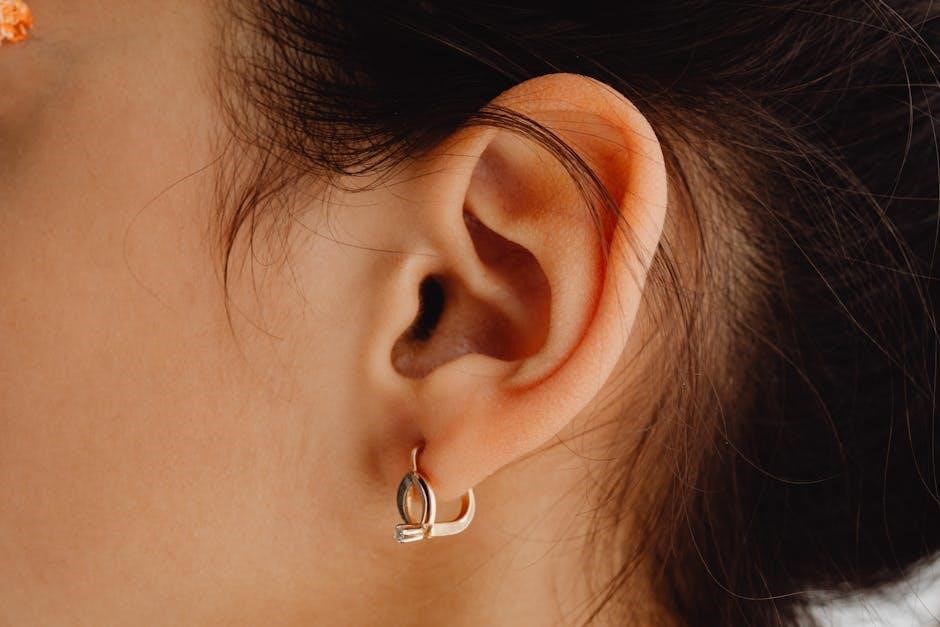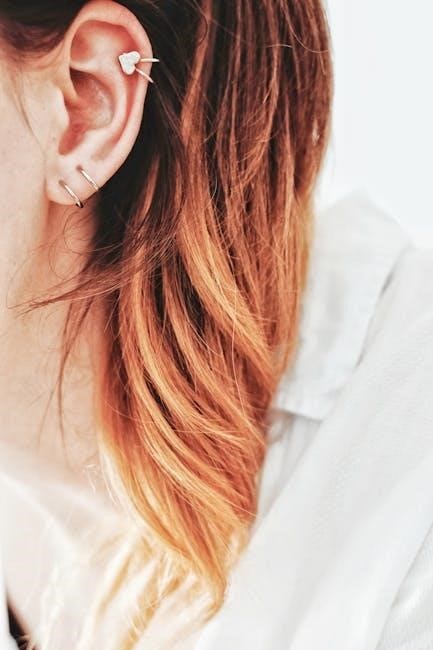Ear piercing is a timeless form of self-expression‚ rich in cultural and symbolic significance. This guide explores various types‚ aftercare‚ and styling tips to help you embrace this art form confidently!
1.1. Popularity and Cultural Significance
Ear piercing has grown exponentially in popularity‚ transcending cultural boundaries. Historically‚ it symbolized status‚ spirituality‚ or identity. Today‚ it’s a fashion staple‚ with curated ear styles trending on social media. Its universal appeal lies in its versatility‚ allowing individuals to express uniqueness and creativity. From traditional lobe piercings to intricate cartilage designs‚ ear piercing continues to evolve‚ blending tradition with modern aesthetics.
1.2. Brief Overview of the Guide
This comprehensive guide covers everything you need to know about ear piercing‚ from types and placements to aftercare and styling. It explores pain levels‚ costs‚ and safety considerations‚ while also addressing common mistakes to avoid. Whether you’re a first-timer or looking to expand your ear styling‚ this guide provides expert tips and insights to help you make informed decisions and feel confident throughout your piercing journey.

Types of Ear Piercings and Their Placements
Explore various ear piercing types‚ each with unique placements‚ from the classic lobe to intricate cartilage piercings like helix‚ tragus‚ and conch‚ tailored to your personal style.
2.1. Lobe Piercing
The lobe piercing is a classic choice‚ known for its simplicity and versatility. Located on the soft tissue of the earlobe‚ it is the most common and accessible piercing. With minimal pain and quick healing‚ it’s ideal for all ages. Suitable for both delicate studs and bold earrings‚ lobe piercings offer endless styling options‚ making them a timeless favorite for many.
2.2. Helix Piercing
The helix piercing is situated on the upper rim of the ear‚ offering a sleek and modern aesthetic. It involves piercing the cartilage‚ which can be slightly more painful than the lobe. Healing times are longer‚ typically several months. Helix piercings are popular for their versatility‚ allowing for various jewelry styles like hoops‚ studs‚ and dangles. They’re a great choice for those seeking a subtle yet striking look.
2.3. Tragus Piercing
The tragus piercing is located on the small flap of cartilage in front of the ear canal. It’s a delicate area‚ making the piercing slightly more painful than the lobe. Healing typically takes 6–9 months. This style is popular for its unique‚ subtle look and works well with studs or small hoops. It’s a great choice for those seeking a trendy yet understated addition to their ear aesthetic.
2.4. Conch Piercing
The conch piercing is situated in the inner shell of the ear‚ offering a stylish and versatile look. It’s a favorite among piercers due to its aesthetic appeal. Healing typically takes 6–12 months‚ and it’s moderately painful. This piercing works well with hoops‚ studs‚ or rings‚ making it a great choice for those aiming for a bold yet elegant ear statement.
2.5. Daith Piercing
The Daith piercing is located on the inner cartilage of the ear‚ near the ear’s base. It’s known for its unique appearance and is often sought for aesthetic and cultural reasons. The piercing process can be moderately to highly painful due to the cartilage. Healing typically takes 6–12 months‚ and small rings or studs are ideal jewelry choices. Proper aftercare is essential to avoid complications and promote healing.
2.6. Rook Piercing
The Rook piercing is situated in the upper cartilage of the ear‚ between the helix and Daith. It’s a popular choice for those seeking a bold‚ edgy look. Jewelry options include hoops or studs. The pain level is moderate to high due to the cartilage. Healing typically takes 6–12 months‚ with proper aftercare essential to prevent complications. Keep the area clean to ensure a smooth healing process.
The Ear Piercing Process
The ear piercing process involves preparation‚ precise technique‚ and aftercare. It’s performed in a clean environment using a piercing gun or needle‚ ensuring safety and accuracy for a smooth experience.
3.1. Preparation for Piercing
Proper preparation ensures a safe and smooth piercing experience. Choose a reputable piercer‚ sanitize the area thoroughly‚ and avoid piercing if you have active skin conditions. Attend with a parent or guardian if underage and stay calm to minimize stress during the procedure.
3.2. The Piercing Procedure
The piercing procedure involves marking the spot‚ using a sterile needle or piercing gun‚ and inserting the jewelry. A professional piercer ensures accuracy and safety. The process is quick‚ with mild discomfort during the needle insertion. Proper hygiene and high-quality tools are essential to minimize risks and promote smooth healing.

Aftercare and Healing
Proper aftercare ensures smooth healing. Clean piercings regularly‚ avoid irritants‚ and maintain hygiene. Healing times vary‚ but consistency and patience are key for optimal results and comfort.
4.1. Cleaning and Maintenance
Regular cleaning is essential for healing. Use saline solution or mild soap to gently clean piercings twice daily. Avoid harsh chemicals or submerging in water. Pat dry with a clean towel to prevent moisture buildup‚ which can lead to infections. Proper maintenance ensures a smooth recovery and prevents complications‚ keeping your piercings healthy and looking their best.
4.2. Healing Times for Different Piercings
Healing times vary by piercing type. Lobe piercings typically heal within 6-8 weeks‚ while cartilage piercings may take 3-6 months. Factors like proper aftercare and piercing location influence recovery. Ensure patience and adherence to care routines to promote optimal healing and minimize complications for all ear piercings.
4.3. Signs of Complications
Watch for signs of complications‚ such as excessive redness‚ swelling‚ discharge‚ or increased pain. If healing stalls or symptoms worsen‚ it may indicate infection. Scarring can occur if issues aren’t addressed. Consult a professional or doctor promptly to prevent long-term damage and ensure proper treatment for any complications arising from your ear piercing.

Choosing the Right Jewelry
Choosing the right jewelry balances style and comfort. Select high-quality‚ safe materials and ensure proper fit for your piercing type. Consult experts for the best options.
5.1. Jewelry Styles for Different Piercings
Ear piercings offer diverse styling options. Lobe piercings suit studs‚ hoops‚ or dangle earrings‚ while helix piercings often feature delicate studs or minimal hoops. Tragus and daith piercings look great with small rings or studs. Conch piercings can showcase larger hoops or orbital rings‚ and rook piercings are ideal for captive bead rings or barbells. Choose jewelry that complements your piercing location and personal style for a polished look.
5.2. Jewelry Materials and Safety
Choosing safe jewelry materials is crucial for ear piercings. Opt for hypoallergenic options like 14k gold‚ surgical stainless steel‚ or titanium to minimize the risk of allergic reactions. Avoid low-quality metals or plastic‚ especially for fresh piercings. Ensure jewelry is properly sterilized and crafted for piercing safety. Selecting reputable materials promotes healing and prevents complications‚ ensuring your piercing remains healthy and comfortable.
5.3. Jewelry Sizing and Fit
Proper jewelry sizing ensures comfort and promotes healing. Measure your piercing area to select the right diameter and length. A snug fit prevents irritation‚ while excessive tightness can hinder healing. Opt for jewelry designed for your specific piercing type‚ as one-size-fits-all pieces may not suit everyone. Consulting a professional piercer can help you choose the ideal fit for your unique anatomy and piercing location.
Pain Levels and Tips

Pain levels vary by piercing type‚ with cartilage piercings generally more uncomfortable than lobe piercings. Breathing techniques or topical numbing agents can help manage discomfort during the process.
6.1. Pain Levels for Different Piercings
Ear piercing pain varies by type. Lobe piercings are generally mild‚ while cartilage piercings‚ like helix or rook‚ can be more painful due to thicker tissue. The tragus and daith piercings fall in the moderate range‚ with some discomfort during and after the procedure. Pain is subjective‚ so individual experiences may differ based on tolerance and piercing location.
6.2. Managing Pain During Piercing
Managing pain during ear piercing involves staying calm‚ breathing deeply‚ and focusing on relaxation. Professional piercers often recommend numbing creams or ice to reduce discomfort. Keeping the body hydrated and avoiding stress can also help. Remember‚ the pain is temporary‚ and the result is worth it. A skilled piercer will guide you through the process to ensure a smooth experience.

Cost and Factors Affecting Price
Ear piercing costs vary based on location‚ piercer expertise‚ jewelry quality‚ and aftercare. Higher prices often reflect better safety and hygiene standards‚ ensuring a worthwhile investment.
7.1. Average Costs for Different Piercings
Lobe piercings are typically the most affordable‚ ranging from $20 to $50. Cartilage piercings‚ such as helix or tragus‚ cost between $40 to $75. More intricate piercings like conch or daith can range from $60 to $100 or more‚ depending on the studio and jewelry selected. Prices often include the piercing procedure and initial jewelry‚ reflecting the complexity and location of the piercing.
7.2. What Affects the Price of Piercings
The cost of ear piercings varies based on factors like the studio’s reputation‚ piercer expertise‚ and jewelry quality. High-end materials or intricate designs increase prices. Location also plays a role‚ with urban areas often charging more. Additionally‚ the piercing type‚ such as cartilage or lobe‚ influences the cost due to differing complexity levels and aftercare requirements. These elements collectively determine the final price of the piercing service.

Styling and Curating Your Ear Look
Curate a unique ear style by mixing piercing types and jewelry. Personalize your look with bold stacks or minimal designs‚ reflecting your individuality and current trends in ear fashion.
8.1. Creating a Personalized Ear Style
Creating a personalized ear style involves blending different piercing types and jewelry. Start with a focal point‚ like a bold helix hoop‚ and balance it with delicate studs. Mix textures‚ such as matte and shiny finishes‚ to add depth. Consider your wardrobe and lifestyle to ensure your look is both stylish and practical. Experiment with layers and proportions to craft a unique aesthetic that reflects your personality and current trends in ear fashion.
8.2. Popular Trends in Ear Piercing
Current trends emphasize curated ear looks with statement pieces and delicate accents. Stacking multiple piercings‚ like pairing helix hoops with tragus studs‚ is increasingly popular. Minimalist styles‚ such as small hoops and subtle studs‚ are also in vogue. Bold cartilage earrings and mixed-metal jewelry add a modern touch. Social media platforms like Instagram and TikTok showcase these trends‚ inspiring individuals to experiment with unique combinations and express their personal styles through their ear adornments.
Safety and Age Considerations
Ear piercing safety is crucial‚ especially for children. It’s best to wait until they’re old enough to care for their piercings. Popular styles like conch piercings are trending‚ offering a cute and trendy look for many.
9.1. Recommended Age for Piercings
Parents often wonder about the ideal age for ear piercings. Experts recommend waiting until a child is at least 8 years old‚ as they can actively participate in aftercare. For infants‚ it’s advised to consult a pediatrician to ensure safety and proper healing.
9.2. Ensuring Safety for Children
Ensuring safety for children involves proper supervision and hygienic conditions. Parents should choose experienced piercers and use hypoallergenic jewelry to minimize risks. Regular aftercare is crucial‚ and children should be taught to avoid touching their piercings to prevent infections.
Common Mistakes to Avoid
Avoid improper aftercare‚ touching piercings excessively‚ and choosing unsuitable jewelry. Ignoring healing times and using low-quality materials can lead to complications. Always follow expert advice for safe results.
10.1. Mistakes in Aftercare Routine
Common aftercare mistakes include over-washing‚ which can dry out the piercing‚ and using harsh chemicals like hydrogen peroxide‚ which can slow healing. Avoid submerging piercings in water too soon and never touch or rotate jewelry excessively‚ as this can introduce bacteria. Additionally‚ using unapproved cleaning solutions or neglecting to clean regularly can lead to complications. Proper aftercare is essential for smooth healing and preventing infections.
10.2. Choosing the Wrong Jewelry
Selecting inappropriate jewelry can hinder healing and cause discomfort. Avoid low-quality materials like untested metals‚ as they may trigger allergies. Jewelry that’s too tight or ill-fitting can restrict blood flow‚ while overly bulky pieces may irritate surrounding skin. Choosing styles unsuitable for your piercing type‚ such as delicate studs for cartilage‚ can lead to discomfort and prolong healing times. Always opt for hypoallergenic‚ high-quality materials and proper fits to ensure comfort and safety.
Ear piercing is a journey of self-expression and confidence. With proper care‚ the right jewelry‚ and a personal touch‚ you can embrace your unique style and shine effortlessly!
11.1. Final Tips and Encouragement
Embrace your ear piercing journey with confidence! Choose jewelry that reflects your personality and ensures comfort. Maintain proper aftercare routines for optimal healing. Be patient‚ as healing times vary. Consult professionals for personalized advice. Remember‚ your ears are a canvas for self-expression. Shine with your unique style and enjoy the transformative power of ear piercings! ✨
